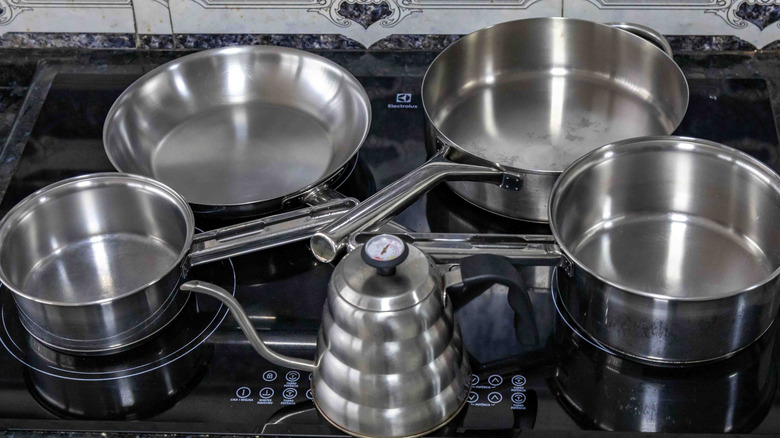Is It Safe To Use Any Type Of Pan On Your Induction Stovetop? Here's What To Know
Buying new cookware for the kitchen can be confusing nowadays, especially as the technology around them becomes more complex. There are major differences between various stove types, so ensuring that the cookware you are purchasing will work on the style you have at home is imperative. If you have an induction stove, check if the cooking utensil you are eyeing is compatible with induction technology. Because even though you can safely use any type of pan on this cooktop, not all of them are going to effectively conduct heat. Some pots or pans will struggle to heat up or not heat up at all due to lacking components needed for the system to work.
An induction stove is powered by electromagnetic energy, utilizing ferromagnets to produce and transfer heat from the cooktop to the cookware. Cooking utensils that use the same type of magnets to conduct heat from an induction stovetop are typically labeled "induction-compatible" at the bottom of the pan or on their packaging. However, even your old cookware may be suitable for use despite not having this label. "If your pan boasts a magnetic stainless steel, cast iron, enameled iron, or nickel base, it's induction cooktop compatible," Mike Williams, vice president for sales and marketing of cookware brand Kenyon, told Martha Stewart. This is because metallic pots and pans made of iron and nickel are also ferromagnetic, making them safe and effective for use on an induction stove.
How to check if your cookware is compatible with your induction stove
Induction technology uses ferromagnetic components to produce heat directly in the compatible cookware. This mechanism doesn't cause the cooktop itself to heat up. Unlike electric stoves that use metal coils to generate and transmit heat from their top surface, induction cooking is safe to the touch since the top of the appliance remains cool. The same mechanism is responsible for making an induction stove safe for all cookware. However, being safe here does not guarantee that your cookware will work. If your pot or pan does not have metallic materials that are strongly attracted to magnets, like iron, cobalt, or nickel, they are unlikely to conduct heat.
Checking if a magnet can stick to the bottom of your utensil is one way to confirm compatibility. While you might be pleased that most of your old cookware, including cast iron pans, can pass the magnet test and work with your induction stove, you'll be surprised to know that some of them won't. Nonstick pans made of aluminum and some stainless steel cookware made of austenitic alloys are not suitable for induction cooking because they are non-magnetic. As such, they won't heat up on the induction stove even if you adjust heat settings to high. Do note that some pots and pans may have a weak magnetic attraction, so even though the magnet can stick to them, they won't be as efficient when used on an induction stove. Those with bottoms that aren't perfectly flat may also struggle to conduct the magnetic field.
Making non-compatible cookware induction-ready
It's looking like induction stoves will be the big kitchen trend in 2026, so you're ahead of the game if you already have one or are in the process of making the switch. However, if you are worried about your old pots and pans that are not compatible with induction technology, you might be interested to know that there are ways to make these utensils induction-ready. The first option is to use an induction adapter. This is a disk-shaped plate that you place on top of the induction stove. Since this accessory is made of a magnetic material, it can generate heat through the electromagnetic field from the stovetop. The heat is then transferred to the utensil.
Other options that do the same for non-induction-compatible cookware include using a heat diffuser plate, or placing magnetic strips along the bottom of your pan. All three alternatives are made of metal, so they follow the same mechanism as compatible utensils, acting as a conduit for the magnetic field to generate heat from the induction cooktop. Such heat is then redirected to the incompatible cookware. It's important to note that this defeats the purpose of the induction stove's safety feature, which prevents burns from accidental touches to the top surface, as these accessories get hot the same way the base of induction-ready cookware do. You can find these induction solutions online and at specialty kitchen stores and department stores. By making your old cookware induction-ready, you are giving it new life in your induction-powered kitchen.


